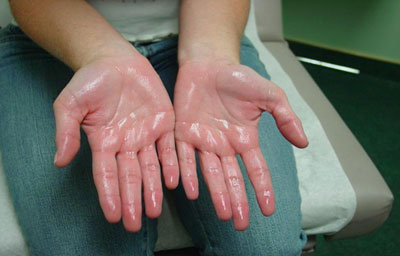CH Baktawar Singh Rd, Medicity, Islampur Colony, Sector 38, Gurugram, Haryana 122001

Palmar hyperhidrosis affects up to 3% of the population and inflict significant impact on quality of life. It is characterized by chronic excessive sweating, not related to the necessity of heat loss. It evolves from a localized hyperactivity of the sympathetic autonomic system and can be triggered by stressful events. It inflicts significant impact on quality of life of patients, interfering with their labor, daily activities, social interaction and leisure, and can cause emotional and psychological distress.
.webp)
Symptoms are usually bilateral and symmetrical and there are no other associated conditions. Palms are cold, wet and present color that can ranges from pale to blush. The episode of sweating has abrupt onset, related or not with emotional stressful events, and presents more intensely on the palms and fingers and less intensely in the posterior regions of the hands. Rapidly, the hands are wet by the droplet detachment, and in some cases there may be swelling of the fingers.

Hyperhidrosis best treated by VATS
The Palmar Hyperhidrosis diagnosis is eminently clinical, being conducted through history and physical examination. Individuals with palmar hyperhidrosis present cold and wet hands with color that can ranges from pale to blush. Plantar hyperhidrosis often (57% of cases) is associated with palmar hyperhidrosis, being described by some authors as part of the symptomatology of these individuals.
The main diagnostic criteria include visible sweat, exaggerated and located, lasting at least six months, without apparent cause, and with at least two of the following characteristics:
PH can be evidenced from the Minor test (starch-iodine), in which an alcoholic solution of iodine 2% is applied in the test area and subsequently starch (e.g. cornstarch) is sprinkled. The hyperhidrotic area solubilizes the iodine, which promotes a complexation reaction with the starch. As the iodine atoms are trapped in the helices of amylose chains, there is evidence of a dark blue staining.
Treatment remains a challenge: options include topical and systemic agents, iontophoresis, and botulinum toxin type A injections, with surgical sympathectomy as a last resort. None of the treatments is without limitations or associated complications.
Topical aluminum chloride hexahydrate therapy and iontophoresis are simple, safe, and inexpensive therapies; however, continuous application is required because results are often short-lived, and they may be insufficient.
Systemic agents such as anticholinergic drugs are tolerated poorly at the dosages required for efficacy and usually are not an option because of their associated toxicity.
While botulinum toxin can be used in treatment-resistant cases, numerous painful injections are required, and effects are limited to a few months.
Most of these treatments give a temporary relief to the patients.
Bilateral VATS sympathectomy is the treatment of choice. The safety and reliability of treatments for palmoplantar hyperhidrosis have improved dramatically, but side effects and compensatory sweating are still not uncommon.
This condition can permanently be treated by a surgical procedure through key-hole incisions. Usual hospital stay would be 1 or 2 days.
Excessive sweating can be quite uncomfortable and embarrassing for the people suffering from it. Thus, learning more about it and treating it with a hyperhidrosis doctor in Gurgaon as soon as possible should be a primary course of action for long-term results.
Nonetheless, before selecting a doctor, be sure to ask them about the Hyperhidrosis treatment cost in India. For further information or to schedule a consultation with Dr. Harsh Vardhan Puri.
You can typically address palmar hyperhidrosis with a minimal cost range depending on the chosen method varying from Botox injections to surgical procedures such as endoscopic thoracic sympathectomy (ETS). In India's healthcare system treatment costs range from INR 1. 5 lakh to 2 lakh approximately so it's advisable to consult with Dr.Harsh Vardhan Puri for an evaluation of your condition.
The best way to deal with sweaty palms depends on how much treatment is needed and what the patient prefers. Options to consider are;
ETS, a favored approach, by professionals, offers lasting relief with side effects according to experts in the field.
The cost of hyperhidrosis treatment for hands ranges from INR 1,00,000 to 2 lakh for ETS surgery. The cost is dependent on the overall plan they set for you and how many sessions you need. Dr. Harsh Vardhan Puri also gives consultations regarding the ideal treatment and the cost that is likely to be incurred.
Treating sweaty palms can cost between INR 20,000 and INR 80,000 for temporary treatments like Botox and up to INR 1,00,000 to 2 lakh for permanent solutions like ETS. Costs include consultation fees, diagnostic tests, and treatment expenses. Visit Dr. Harsh Vardhan Puri in Gurgaon to explore tailored options.